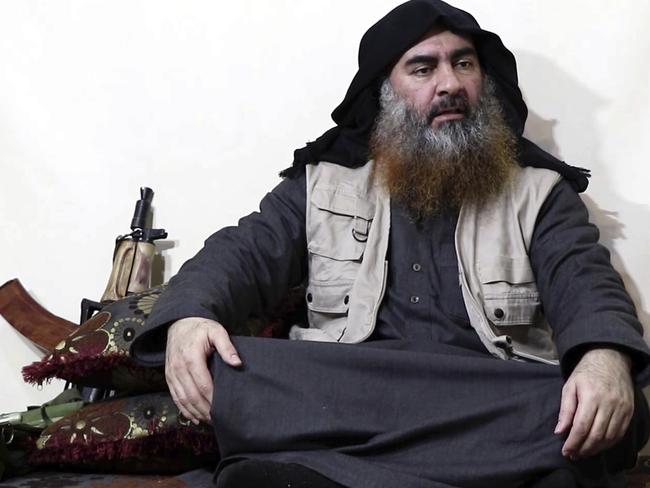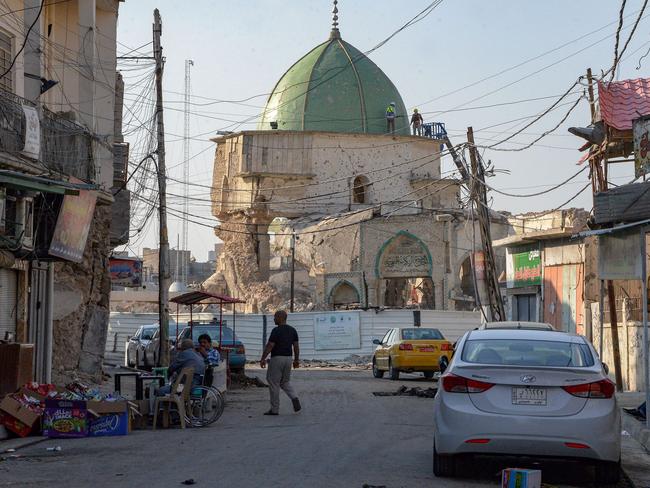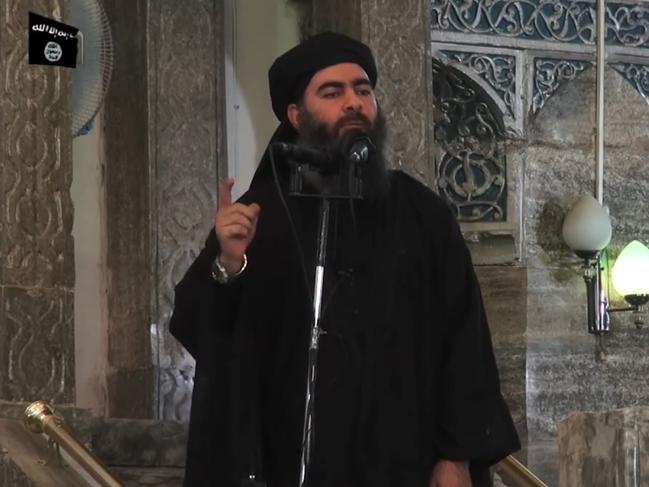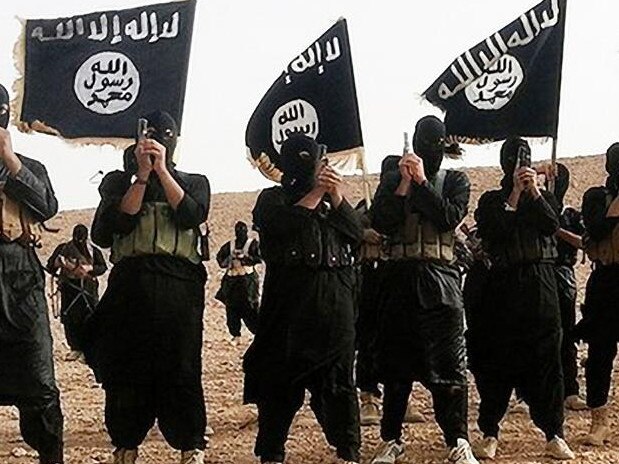Abu Bakr al-Baghdadi’s death signals the end of the IS era
US President Donald Trump has announced that IS leader Abu Bakr al-Baghdadi has been killed in a military strike, but is this the end of the Islamic State?
Abu Bakr al-Baghdadi, the leader of the Islamic State group, was killed in a US military raid in Syria, US President Donald Trump announced from the White House at 10am (1am AEDT).
Mr Trump says the military raid that took out the IS leader was a bigger deal than the 2011 killing of Osama bin Laden during the Obama administration.
— Donald J. Trump (@realDonaldTrump) October 27, 2019
Detailing the operation during an announcement at the White House, the US president acknowledged that the death of bin Laden was significant, but he believes the news about al-Baghdadi is even bigger.
Mr Trump said that bin Laden didn’t become a global name in terrorism until the attacks of Sept. 11, 2001 whereas al-Baghdadi was responsible for building an entire caliphate — and for attempting to rebuild it up until the time of his death.

WHO WAS AL-BAGHDADI?
Abu Bakr al-Baghdadi, the shadowy leader of the Islamic State group, presided over IS’s global jihad and became arguably the world’s most wanted man, with a $25 million (A$36.65 million) bounty on his head.
Born Ibrahim Awwad Ibrahim Ali al-Badri al-Samarrai in 1971 in Samarra, Iraq, he adopted the norm de guerre al-Baghdadi early on and joined the Sunni insurgency against US forces after the 2003 invasion.
He was detained by US troops in February 2004 and spent 10 months in the Camp Bucca prison in southern Iraq.
He eventually assumed control of the Islamic State of Iraq, an al-Qaeda linked group founded by Abu Musab al-Zarqawi, a Jordanian militant killed in a US air strike in Iraq in 2006. Under al-Baghdadi, the group expanded into neighbouring Syria, exploiting the chaos unleashed by that country’s 2011 uprising and civil war.

He lead IS for the last five years, presiding over its ascendancy as it cultivated a reputation for beheadings and attracted hundreds of thousands of followers to a sprawling and self-styled caliphate in Iraq and Syria.
He remained among the few IS commanders still at large despite multiple claims in recent years about his death and even as his so-called caliphate dramatically shrank, with many supporters who joined the cause either imprisoned or jailed.
Al-Baghdadi’s exhortations were instrumental in inspiring terrorist attacks in the heart of Europe and in the United States.
In the US, multiple extremists have pledged their allegiance to al-Baghdadi on social media, including a woman who along with her husband committed a 2015 massacre at a holiday party in San Bernardino, California.
MORE NEWS
Revealed: Terrorists still wanted
‘Death truck’ suspects released on bail
‘Rot in hell’: Notorious serial killer Ivan Milat dies
Dad finds daughters’ dead bodies in home
Rebels plotting to ‘take over’ UK parliament
He’d kept a low public profile in recent years, releasing only sporadic audio recordings.
In a recording just last month, he called on members of the extremist group to do all they could to free IS detainees and women held in jails and camps.
That purported audio was his first public statement since last April, when he appeared in a video for the first time in five years.
The video included images of the IS leader sitting in a white room with three others. He praised Easter Day bombings that killed more than 250 people and called on militants to be a “thorn” against their enemies.

HOW AL-BAGHDADI BUILT HIS CALIPHATE
Al-Baghdadi’s fighters captured a contiguous stretch of territory across Iraq and Syria, including key cities, and in June 2014, it announced its own state — or caliphate.
Al-Baghdadi became the declared caliph of the newly renamed Islamic State group.
Under his leadership the group carried out a wave of atrocities, including the enslavement and rape of thousands of women from Iraq’s Yazidi minority.
They massacred captives, beheaded journalists and aid workers, and threw individuals believed to be gay from the rooftops of buildings.
They gleefully broadcast the killings with slickly produced videos and photos on social media.
Shifting away from the airline hijackings and other mass-casualty attacks that came to define al-Qaeda, al-Baghdadi and other IS leaders supported smaller-scale acts of violence that would be harder for law enforcement to prepare for and prevent.
They encouraged jihadists who could not travel to the caliphate to kill where they were, with whatever weapon they had at their disposal.

In 2014, he was a black-robed figure delivering a sermon from the pulpit of Mosul’s Great Mosque of al-Nuri, his only known public appearance.
He urged Muslims around the world to swear allegiance to the caliphate and obey him as its leader.
“It is a burden to accept this responsibility to be in charge of you,” he said in the video.
“I am not better than you or more virtuous than you. If you see me on the right path, help me. If you see me on the wrong path, advise me and halt me. And obey me as far as I obey God.”
HOW AL-BAGHDADI WAS CAUGHT AND KILLED
A senior Turkish official says that “to the best of my knowledge,” al-Baghdadi arrived at a location in Syria 48 hours before the US military raid that’s believed to have targeted the Islamic State group leader.
The Turkish official says in a written statement on Sunday local time that there’s been “close co-ordination” among relevant parties and that the Turkish military had advanced knowledge of the raid.
Turkey’s army said earlier in a tweet that it had “information exchanged and co-ordination” with US military authorities before the operation.

The US raid with helicopters took place in the Barisha area north of Idlib city, a few kilometres from the Turkish border.
Iraqi intelligence officials located the hide-out of Islamic State leader Abu Bakr al-Baghdadi ahead of the US strike that killed him in Syria, the Iraqi military says.
The army said in a statement on Sunday that Iraq’s national intelligence agency identified the hide-out of al-Baghdadi and his followers in the Syrian province of Idlib after a special team was formed to collect intelligence about his whereabouts over the course of a year.

“As a result, US forces, in co-ordination with the Iraqi national intelligence agency, carried out a military operation which led to the elimination of al- Baghdadi and those with him,” the army said.
“This is a new victory added to other victories achieved by our heroic security forces,” it added.
WHAT HIS DEATH MEANS
Though at minimum a symbolic victory for Western counter-terrorism efforts, his death has unknown practical impact on possible future attacks.
He had been largely regarded as a symbolic figurehead of the global terror network, and was described as “irrelevant for a long time” by a coalition spokesman in 2017.
The announcement of his death comes as Mr Trump has been on the receiving end of bipartisan criticism in Washington following the recent pullback of US troops from northeastern Syria, which critics feared would allow the militant group to regain strength after it had lost vast stretches of territory it had once controlled.
News of the Islamic State leader’s death is seen as a foreign policy victory for Mr Trump who kept the mission secret from Washington, whuch he called a “leaking machine.”
The success of the mission could also boost Mr Trump’s popularity at a time when impeachment pressure is increasing.

While al-Baghdadi’s death is a major blow, the extremist group has survived the loss of previous leaders and military setbacks going back to the aftermath of the 2003 US-led invasion of Iraq.
Al-Baghdadi never publicly designated a successor, and many of his top deputies have been killed. His death could spark infighting among prospective successors, potentially further weakening the group.
IS THIS THE END OF THE ISLAMIC STATE?
The Islamic State group in its various forms has survived the death of several leaders and senior commanders. It has been able to replenish its ranks by attracting Sunni Muslims in the Middle East who feel oppressed by their governments, as well as foreigners attracted by the group’s austere vision of Islam, its ultra-violent tactics, or both.
It still boasts powerful affiliates in other countries, and remnants of the original group continue to carry out sporadic attacks in both Syria and Iraq.

Perhaps even more worrying are the tens of thousands of IS fighters and supporters detained across the Middle East, including those held by Kurdish fighters in eastern Syria.
The US decision this month to pull out of Syria and abandon its former allies to a Turkish invasion allowed hundreds of IS supporters to escape and raised concerns about the security of other facilities.
It’s possible that a future IS leader is wearing a prison jumpsuit, quietly recruiting supporters within concrete walls lined with barbed wire and plotting his next move — just as al-Baghdadi once did.
Originally published as Abu Bakr al-Baghdadi’s death signals the end of the IS era
